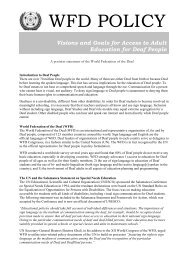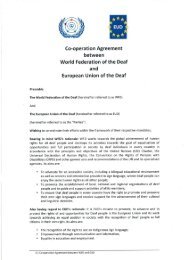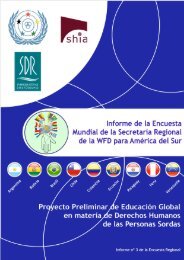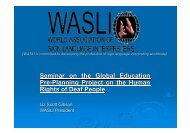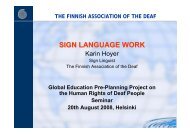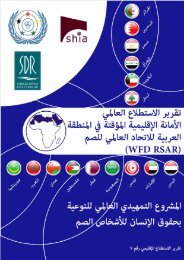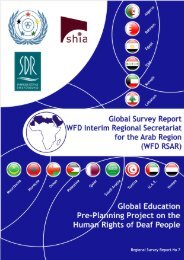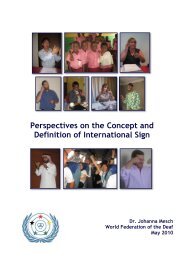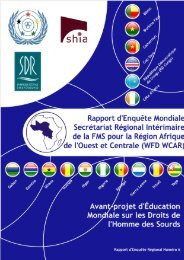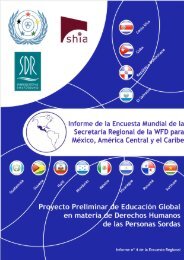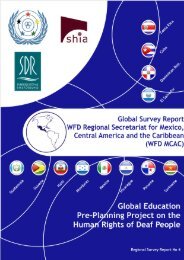RSA/P Regional Survey Report No 2 (English Version) PDF - World ...
RSA/P Regional Survey Report No 2 (English Version) PDF - World ...
RSA/P Regional Survey Report No 2 (English Version) PDF - World ...
Create successful ePaper yourself
Turn your PDF publications into a flip-book with our unique Google optimized e-Paper software.
Philippines<br />
Republic of Korea<br />
Sri Lanka<br />
Thailand<br />
6. Profile<br />
• Deaf Association is a recognised, valued and highly regarded organisation<br />
7. Government/Stakeholders<br />
• The Deaf Association has effective collaborative relationships with national and local government<br />
and key stakeholders to ensure their policies and procedures are effective for Deaf people<br />
1. Livelihood/Employment<br />
2. Sign Language<br />
1. Abolishment of the limits on driving licenses for Deaf people<br />
2. Security of society participation for Deaf people<br />
3. Improvement of policies affecting Deaf people<br />
4. Development and passage of a sign language law<br />
5. Build a hall<br />
<strong>No</strong> information supplied.<br />
1. Interpreting<br />
2. Sign Language Teaching<br />
3. Skills Training<br />
4. Education (Literacy)<br />
5. Health and Safety<br />
6. Sports<br />
7.2.7 Please describe the structure of your National Association of the Deaf/Deaf Group (e.g. congress/annual<br />
meeting/board/executive/districts/local associations and so forth).<br />
Country<br />
Australia<br />
Cambodia<br />
Indonesia<br />
Japan<br />
Laos<br />
Malaysia<br />
Nepal<br />
New Zealand<br />
Philippines<br />
Republic of Korea<br />
Please describe the structure of your National Association of the Deaf/Deaf Group (e.g. congress/annual<br />
meeting/board/executive/districts/local associations and so forth).<br />
• National organisation managed by a Board. Day to day running of the organisation is delegated to paid<br />
staff, with the board setting the directions and approving strategic plans and budgets. The board<br />
meets 3 or 4 times per year.<br />
• There is a state branch in each of the 6 Australian states. These state branches are separately<br />
incorporated organisations and are run by a board of management of their own. Deaf Australia and the<br />
state branches share members – ie when a member living in, for example Victoria, joins Deaf Australia,<br />
they automatically become a member of the Victorian branch also.<br />
• Deaf Australia holds an Annual General Meeting each year, usually in <strong>No</strong>vember. All ordinary (Deaf)<br />
members have a vote, and each state branch also has three votes each as an organisation member.<br />
• State branches also have their own Annual General Meeting at different times.<br />
• Local associations can be members of their State branch.<br />
DDP is creating a foundation for a national association by establishing Deaf groups in various parts of the<br />
country. We hope eventually they will form a Deaf community. Eventually leadership will emerge and form<br />
a national association.<br />
Provided organisational chart.<br />
Provided organisational chart.<br />
The Deaf-Mute Unit was accepted by Lao Disabled People’s Association of the Ministry of Labour and Social<br />
Welfare.<br />
• Malaysian Federation of the Deaf (MFD) is a national self-help organisation, administered by Deaf<br />
people<br />
• MFD is represented by 13 state organisations (local associations)<br />
• MFD has an annual meeting and the MFD Board is elected every two years<br />
• Annual General Assembly – includes local member organisations in NFDH, which is the umbrella<br />
organisation. Every three years the annual general assembly converts into a congress/convention for all<br />
Deaf board members including the president.<br />
• The Executive Committee is the board that implements all plans and programmes as directed by the<br />
annual general assembly and the constitution. There are 11 Board members, with a minimum of two<br />
female members.<br />
• Executive Committee appoints several committees to work for the board and on implementation of<br />
plans. Each of these committees has a co-ordinator and a secretariat.<br />
• NFDH has committees on: Education, Sign Language, Interpreters, Programme Development, Women,<br />
Human Rights, Culture, Youth, Sports and driver licence registration.<br />
• In every programme and action plan a Deaf person takes the leadership.<br />
• The Executive Board is elected by the members of the organisation (Deaf members only)<br />
• The Annual General Meeting takes place annually (traditionally in <strong>No</strong>vember)<br />
• The Executive Board appoints the Chief Executive<br />
• The Chief Executive operates the organisation under the direction of the Board<br />
• There are 13 offices throughout New Zealand. Each office works with their local community members<br />
Provided organisational chart.<br />
• The main body is the Association of the Deaf<br />
• 16 Local associations<br />
• 146 <strong>Regional</strong> associations<br />
• Sign Language Interpreter Centre<br />
The Project was under the auspices of the Swedish National Association of the Deaf (SDR) and the <strong>World</strong> Federation of the Deaf (WFD), Page <strong>No</strong> 44<br />
and funded by the Swedish Agency for International Development Cooperation (Sida) and Swedish Organisations of Disabled Persons<br />
International Aid Association (Shia).



